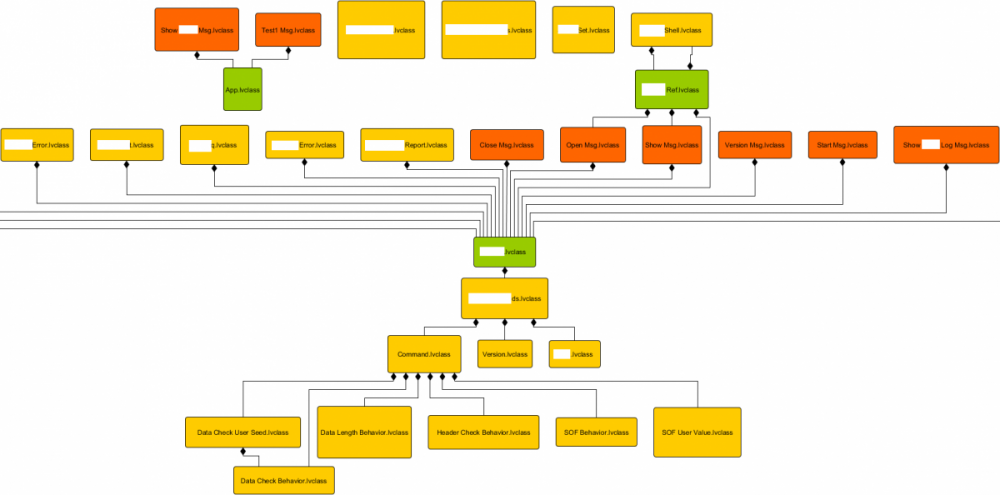-
Posts
335 -
Joined
-
Last visited
-
Days Won
13
Content Type
Profiles
Forums
Downloads
Gallery
Everything posted by todd
-
Not sure about the exposure, but if you want 2 seconds delay between acquisitions, you'll need to change something. One way is to wire the Error Out of the first acquisition into a single-frame sequence that only has the Wait (ms). Then wire the error wire through that frame and into the second acquisition. Does the Vision Assistant allow you to right-click and "convert to code", or so?
-

generic user interface for specific module ui's
todd replied to crush's topic in Object-Oriented Programming
Subpanel is a good way to go. In each child class, there could be a different-named display VI that can insert itself into the subpanel (DisplayType1.vi, DisplayMultiCursor.vi). I've used regular classes for this, as well as AF. -
I would guess that a console app needs, at a minimum, the LabVIEW RTE. A GUI would need the RTE and X.
-
LV-native MD5 hash VIs are included in vi.libUtilityMD5Checksum.llb Openg also has MD5, but no RFC 2574 stuff.
-
Can't find the reference, but someone once said that the buffer size doubles until it's as big as a block (4kB?), then increases by block-sized increments.
-
Have you hit your 10MB limit? The only place I can find to check my current usage is when I try to attach a file. Currently, I have 5.89MB left.
-
Scalar measurement and array measurement sound like different methods, if not different classes. I go back and forth between creating a few classes that cover lots of functionality, and many classes that cover simple tasks. The ones that get reused the most tend to be the simplest (because they're well-understood and they fit easily into any app), and the most complex (because they are the hardest to change - ha!).
-
I don't have CLA exam knowledge, so I'm following this post. A question: Why call Handle Error directly in the ES? That doesn't allow the actor to be stopped, right? I usually try to put code that has meaningful errors inside the actor methods, and if there's an error in the ES, I consider that a hard stop - so after the ES's while loop, I call stop core (and ignore errors if Handle Error already caused a stop). Then send the error to the caller so it can decide to restart. Edit, after looking at it better: Oh, you're using the stop actor output to stop the ES. But this only stops the ES, not the actor. If a method throws an error, and Handle Error stops the actor, how do you stop the actor core ES/while? Typically, I create a user event (type error cluster) that stops the ES. when the "call parent" actor core stops, it's error output triggers this "done" event. I dwelling on error handling, and not offering helpful input. In handle error, I rarely call parent, because I want the option to not stop the actor.
-
This isn't what you're looking for, but it's the beginning of a method I'm trying to refine. It's AF, and it's woefully simple, but it was a starting point for me. In a similar actor that uses visa, when the visa resource name is empty, a child actor is called that allows for simulated/scripted data. StreamDaq.zip
-
I bet if you post your VI on the forums at ni.com, someone would build the exe and post it.
-
Looks like the browser loads the entire page THEN goes to the unread post. When the connection is slow, here, that can take long enough that I start scrolling down.
-
Wish I could send this to the managers I've had over the last 15 years.* Ooh, or to the managers yet to come. * Except for those two blissful years where there was an actual team.
-
I don't see a feedback link on that white paper. The Related Links are all malformed. Checked in IE10 and Firefox.
-
Things I've heard will lose a small number of points and are easy to change: - Use explicit constants in each case of a structure instead of "Use Default If Unwired" - Make a simple text icon for the typedefs
-

Use of In place Structure outside a LabVIEW Class
todd replied to Naity's topic in Object-Oriented Programming
I get the impression that most people who use by-ref classes use IPEs inside the class' methods or inside a "class API". Sometimes, they need more flexibility. http://lavag.org/topic/16354-understanding-preserve-run-time-class-in-an-in-place-element-structure/ -
Another vague answer: Don't over-architect it. The example solutions and the user-submitted solutions here: http://forums.ni.com/t5/Certification/Sample-Exam-Solutions-for-Review/m-p/1824703#U1824703 vary from single-loop control polling, to UE-inside-of-case (think JKI SM), to producer-consumer. Use whatever feels best.
-
If it's just the file type, put the file dialog express VI in a loop and check for a valid extension. I believe the original problem was that, once the file dialog was open, another pattern could be selected - which allows a user to double-click on an .exe file. In 2012, you can right-click on another file and select "open", and it will execute after the file dialog is done.
-
Here's a conversation about execution state: http://forums.ni.com/t5/LabVIEW/Programmatically-distinguish-between-running-and-reserved-vi-s/m-p/2361524/highlight/true#M736114
-
Or add an inheritance mapping. No automation is allowed: http://yed.yworks.com/support/qa/998/yed-via-command-line
- 16 replies
-
Super-cool! Now to get yEd to auto-size and contain the names. Here's the early stage of a project, shown as Heirarchical:
- 16 replies
-
Hello. Yes, that's what "cross-post" means. I put the link here so people would know there was a discussion already underway.
- 6 replies
-
- absolute time
- waveform chart
-
(and 1 more)
Tagged with:
-
Cross-post: http://forums.ni.com/t5/LabVIEW/Problem-with-Waveform-Chart-X-scale/td-p/2431714
- 6 replies
-
- absolute time
- waveform chart
-
(and 1 more)
Tagged with:
-
I don't use auto-populate, and I have not had the need to put data files in the project. Just curious - why do you put data files in the project?
- 5 replies
-
- intensity graph
- cursor
-
(and 3 more)
Tagged with:
-
I agree. They wanted cheap, plug-n-play labor. Management were the "gurus", and staff just executed. That's why I left.



